 |
|
| |
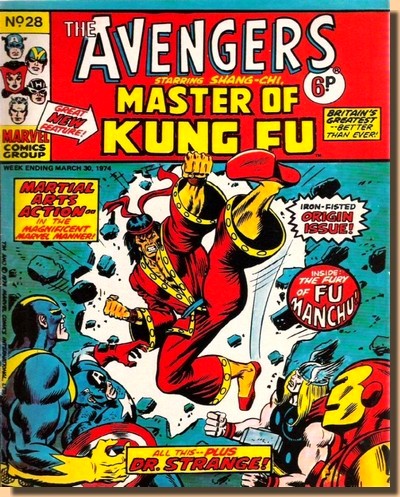 |
|

MARVEL
UK
INSIDE
THE
AVENGERS #28
MARCH
1974
|
|
| |
| In late September 1972 Marvel launched its own UK
imprint (commonly known and refered to as Marvel
UK) with a weekly title called Mighty World
Of Marvel. It was the start of a highly successful
venture onto the British comic book market which would
(re-)introduce a whole array of Marvel characters and a
number of black and white weekly titles throughout the
1970s. |
| |
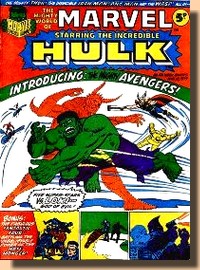
Mighty
World of Marvel #46 introduced the Avengers
(18 August 1973)
|
|
The Mighty
Avengers were introduced into he ranks of Marvel
UK in August 1973 in the pages of Mighty
World of Marvel #46, starting out with the
classic Stan Lee & Jack Kirby origin tale
from Avengers #1, and almost immediately
moved on to their own weekly title in September
1973. The
Avengers also introduced a new production
format - unlike Mighty World of Marvel
and Spider-Man Comics Weekly (launched
in February 1973) the title featured glossy
covers which really embellished the newsstand
appearance of the all black and white content.
For the first 27 issues
the 36 pages had run a full Avengers story (i.e.
reprinting one US issue in its entirety) with the
early 10-page adventures of Doctor Strange from Strange
Tales as a backup strip. But as The
Avengers #28 went on sale during the week
ending March 30th 1974,
this formula was changed.
|
|
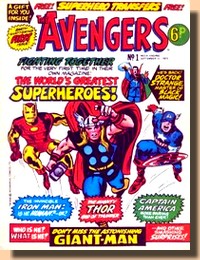
Avengers
#1 brought the number of Marvel UK weeklies
to three
(22 September 1973)
|
|
| |
| Now, The Avengers
began to feature three characters and storylines from the
Marvel Universe, with Shang-Chi, Master of Kung Fu,
joining Earth's Mightiest Heroes and the Sorcerer
Supreme. |
| |
| |

"Shang-Chi, Master of
Kung Fu!"
Originally
published in Special Marvel Edition #15 (December
1973)
Script - Steve
Englehart
Pencils - Jim Starlin
Inks - Al Milgrom
Lettering - Tom Orzechowski
Tones - Mike Esposito
Featuring characters created by Sax
Rohmer
Original page count: 19
Reprinted pages: 10
|
|
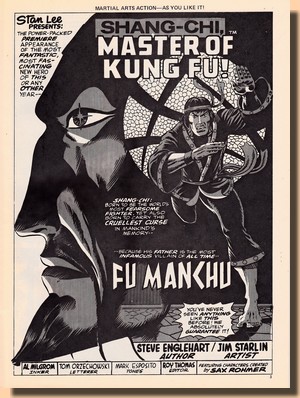
|
|
| |
| Following a growing presence of martial arts
throughout the 1960s in both US and British TV shows
(Bruce Lee as Kato in The Green Hornet being an
example of the first, and Diana Rigg's Emma Peel in The
Avengers of the latter), an influx of genre movies
from Hong Kong snowballed into a full-blown (and mostly
Bruce Lee-fuelled) "karate craze" in 1972/73.
Marvel, still in a phase of genre expansion, had acquired
the rights to Sax Rohmer's Oriental villain Fu Manchu,
and the way Shang-Chi came to be created is rather
typical of many early Bronze Age characters. |
| |
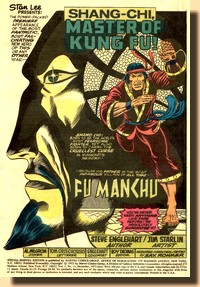
|
|
“I [Steve Englehart] had a few
friends up to my place in Connecticut for a
weekend, and we were about to go out and get
some dinner when Steve Harper, the artist,
said he’d stick around to watch the
second episode of a TV show he liked called
Kung Fu. We were dubious but he put off
dinner for an hour, and I totally fell in
love with that show – as did Jim
Starlin, who was also there. When the third
episode came around, Jim and I were down in
New York, and I guess Jim didn’t have a
TV, so we asked Roy Thomas if we could watch
it at his house. Roy was dubious, and
remained so, but we remained enthralled, so
without my pretense whatsoever, Jim and I
created our own version of what we liked.
Then Roy, who loved old pulp - as did I - had
us add Fu Manchu to the mix.”
(Steve Englehart in: Pearl, 2012)
|
|
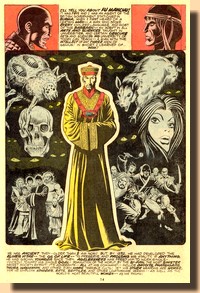
|
|
| |
| Thus created by Steve Englehart and Jim Starlin,
Shang-Chi was given a slot in one of the many tryout
titles Marvel was running at the time and made his first
appearance in Special Marvel Edition #15 with a
December 1973 cover date. In stark contrast to the
Avengers and Doctor Strange material featured in Avengers
#28 (with both stories dating back to 1966), Shang-Chi
was so recent and up to date that one even hesitates to
call it "reprint material". It was more like
Marvel UK was running him on the British market almost in
sync with his US appearances. |
| |
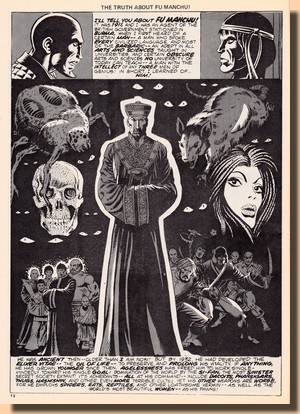 |
|
An instant and huge success in
the States, the Master of Kung Fu takes the
center stage spotlight of Avengers #28
with a story introducing him to the British
readership. This is, of course, the first
Shang-Chi story from Special Marvel Edition #15
- or rather the first ten pages of it. Shang-Chi
is a master of martial arts, a "living
weapon" - and the son of Fu Manchu. When
sent to England and ordered to assassinate a
certain Dr. Petrie whom Fu Manchu describes to
his son as "possibly the most evil man
alive", Shang-Chi only agrees reluctantly
and only because he believes his move serves a
higher and just cause. After the deed is done he
is confronted by Sir Denis Nayland Smith, a
former British intelligence officer, who reveals
the truth about Fu Manchu: An adept in all arts
and sciences and possessing the intellect of any
three men of genius, he has used his immense
power and faculties for the sole purpose of world
domination, becoming the most infamous villain of
all time - and, after having found the famed life
elixier, a nearly immortal evil mastermind.
Smith carries the proof of the sadistic
cruelty of Fu Manchu in his own body, maimed by
the torture applied by the evil villain.
Shang-Chi is shocked and abhorred, and seeks out
his American mother who can only confirm the
dread image painted by Nayland Smith. Revolted,
Shang-Chi vows to seek out his father, who has
wittingly turned him into a killer, and to seek
revenge for himself as well as the many others
who have suffered at the hands of Fu Manchu.
|
|
| |
Clearly one of the Marvel comic books of the early
1970s where writers and artists were aiming at an
audience in the teenage and older age range whilst using
literary characters, it enjoyed a smiliar success as Tomb
of Dracula.
"Nobody else at
Marvel believed in it, but we [Englehart and Starlin]
got a slot in a previously-reprint title called
SPECIAL MARVEL EDITION and we co-created SHANG CHI. I
[Steve Englehart] meditated for a long time on the I
Ching to create his name, which means "The
Rising and Advancing of a Spirit" and I
envisioned the title as a companion book to DR
STRANGE. After just two issues, the series was
such a sensation that the the book officially became
MASTER OF KUNG FU - and -
Marvel added a second book,
the black-and-white DEADLY HANDS OF KUNG FU! Shang
Chi became Marvel's most popular character for years
thereafter. Unfortunately, doubling my work load was
something I couldn't do with such a philosophical
book, and rather than crank it out, I left it. This
was too bad for me, but fortunately it was taken over
by Doug Moench, who went on to work with a series of
great artists like Paul Gulacy and Gene Day to make
it one of Marvel's truly memorable series."
(Steve Englehart on steveenglehart.com)
|
| |
| Master of Kung Fu didn't really work out to
be a companion book to Dr Strange, making the
almost side by side appearance of Shang-Chi and the
Sorcerer Supreme in the pages of Marvel UK's The
Avengers all the more special. |
| |
| The black and white rendition of
this very first Shang-Chi story in this mag was
followed only months later, in June 1974, when it
was also reprinted in a monochrome rendition in
Marvel's US magazine type The Deadly Hands of
Kung Fu #2. For the UK reprint, the colours
were replaced by grey tones, for which the splash
page in Avengers #28 gives Mike Esposito
credit; a comparison of the coloured pages and
those rendered in the UK reprint do indeed show
some reworking. Another addition unique to Marvel
UK's version are the various titles which for
some time adorned the header of every page
(including the Avengers and Dr Strange material)
- a special feature of many UK comic books which
was eventually dropped. Cutting the story in
half meant that some form of indication refering
to the continuation of the story in the next
issue had to be inserted - which in this case
proved very easy as the panel of the last page
reprinted in Avengers #28 left just enough space
to fit in a small box reading "NEXT:
SON VS. FATHER !" ...
In the US Doug Moench (who took over as of Master
of Kung-Fu #21 - the book had taken on that
title as of issue #17 and simply continued the
numbering of Special Marvel Edition)
penned the adventures of Shang-Chi in an action
and espionage adventure vein and pretty much in
tune with Rhomer's later original Fu Manchu
books, whilst remaining true to Englehart's
vision of a spiritual and philosophical (and thus
reluctant) warrior who never wavers in fighting
his father's evil schemes.
|
|
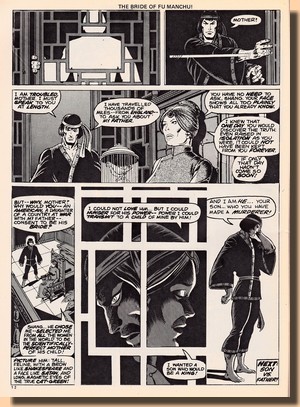
|
|
| |
| Moench would remain the title's main writer until Master
of Kung-Fu #122 (December 1982), when he left Marvel
for DC after prolongued arguments with editor in chief
Jim Shooter, who cancelled the title three issues later. |
| |

Shang-Chi
|
|
In the UK, the
arrival of Shang-Chi in The Avengers #28
meant a change in title for the book, which would
now become The Avengers starring Shang-Chi,
Master of Kung Fu for the next 25 issues -
in fact it was almost as though the Son of Fu
Manchu had effectively taken over the book as he
became the cover feature of Avengers #28
through #51. Master of Kung-Fu came
out in 6th place in the
Comics Bulletin's 2010 "Top 10 1970s
Marvels" (Sacks, 2010) for its "thoughtful
writing and some very intense artwork",
but seemed lost for ever to reprint editions as
Marvel no longer held the licensing rights for
the Sax Rohmer characters. However, in 2016
Marvel reached an agreement with the Sax Rohmer
Estate and published the series in four oversize
hardcover Omnibus volumes in quick succession
between 2016 to 2017.
|
|
| |
| The licensing problem (until the agreement of 2016)
weighed especially on this first Shang-Chi story (which
features all three major personae from Rohmer's novels:
Fu Manchu, Nayland Smith, and Doctor Petrie) - which in
its time was published very quickly in an amazing number
of foreign language editions, namely Swedish (1974, Mästaren
på karate), French (1974, Les Mains de
Shang-Chi, Maitre du Kung-Fu, for the Canadian
market), Italian (1975, Shang-Chi Maestro del Kung Fu)
and German (1976, Die tödlichen Hände des Kung Fu,
for the German, Swiss and Austrian market). Whilst these
were all in colour, two black and white reprints (other
than the Marvel UK reprint) were published in the US in The
Deadly Hands of Kung Fu #2 (June 1974) and Special
Collector's Edition #1 (1975) - both shortened to 15
pages. |
| |
| |

"Never Bug a
Giant!"
Originally
published in Avengers #31 (August
1966)
Script - Stan
Lee
Pencils - Don Heck
Inks - Frank Giacoia
Lettering - Artie Simek
Original page count: 20
Reprinted pages: 10
|
|
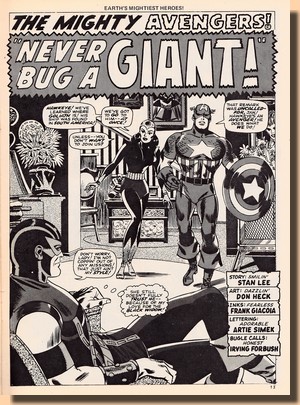
|
|
| |
| Turning over the final page of the Shang-Chi
instalment, readers found themselves in the living room
of Avengers HQ - and at the start of a story from the
Earth's mightiest heroes' classic 1966 period when Stan
Lee and Don Heck were getting into full swing with a
line-up of heroes with no original member left (although
Captain America, who had joined the team in Avengers
#4, felt as though he had been their leader forever) -
and the in-group bickering and provocations between Cap
and Hawkeye were running in top gear. The story is to
the point as Captain America, the Wasp and Hawkeye leave
for South America to help Goliath (to whom the title of
the story refers) while Quicksilver and the Scarlet Witch
are back home in the Balkans, temporarily without super
powers, though yearning to be Avengers once more and
hoping their powers will return soon...
As is usual and typical for the mid-1960s Avengers
material the story consists of a plot build-up and a
subseuqent all-out fight ending with the defeat of the
villain - this second part would be served to UK readers
in The Avengers #29.This plot structure lended
itself rather well to splitting one original US Avengers
story into two segments, but obviously the last page of
"part one" was required to carry some
indication of the "continued next issue" type
which was lacking from the original.
|
| |
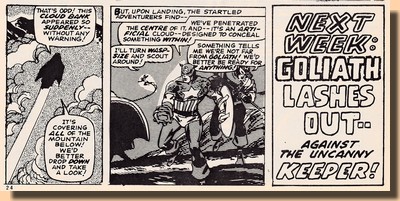
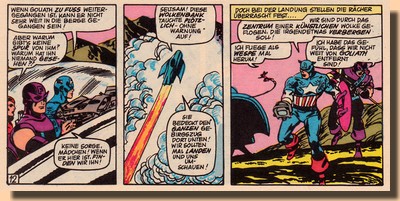 |
|
As seen with the Shang-Chi
example this would sometimes be achieved by
adding a small note to an existing panel, but in
this case editor Peter L. Skingley (who in reality was Petra Skingley
- at the time it was
clearly felt that "boys comics" in
Britain should have male editors, even if by
"pen name" only) opted for a flashier
teaser. As a consequence, the first panel of the
bottom row of that page had to go - as can be
seen in comparison with another reprint version,
Williams Verlag's German language Die Rächer
#30 which presented the entire Avengers
#31 story in colour to readers in Germany,
Switzerland and Austria in March 1976 (comparing
the two rows of panels also highlights how the
shades were often reworked in some areas in order
to get a coherent rendition in black and white -
something not always done very successfully, as
can also be seen from this very same row of
panels). Initially having the Avengers and
Doctor Strange as backup had meant that the
original material could be reprinted over 30
pages without any editorial ado at all. However,
there was a problem.
As Marvel UK followed
the standard British comic book market format by
publishing its titles weekly, it was clear that
by running entire US 20-page issues the British
weeklies would catch up all too quickly with the
original material. It really was an easy
calculation to make: one US issue per weekly
British issue meant reprinting four years' worth
of original US material in one single year for
the UK market.
|
|
| |
| The easiest solution to make
the original material last longer was to cut the Avengers
stories in half, resulting in ten rather than twenty page
instalments per issue. This, however, meant that 10 pages
required some other content. Hence The Avengers
began to feature three characters and storylines from the
Marvel Universe - enter Shang-Chi (and later on Iron
Fist). |
| |
| |

"The Pincers of
Power!"
Originally
published in Strange Tales#140 (January
1966)
Script - Stan
Lee
Pencils - Steve Ditko
Inks - Steve Ditko
Lettering - Sam Rosen
Original page count: 10
Reprinted pages: 10
|
|
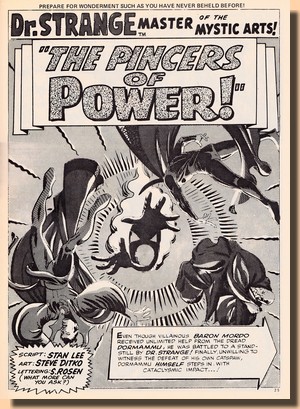
|
|
| |
| The third feature of Avengers #28 is also
the oldest material reprinted, dating from 1965 and
published with a cover date of January 1966 in the US. |
| |
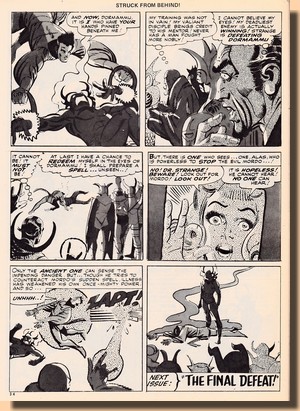 |
|
At that point in time, Dr
Strange, the Master of the Mystic Arts, shared
the pages of Strange Tales with
S.H.I.E.L.D.'s Nick Fury, meaning that he only
had a monthly page count of 10. For readers of
Marvel UK's The Avengers this in turn
meant that they were getting full length reprints
of the stories as originally presented.
In "The Pincers of Power", the dread
Dormammu - who is challenging Dr Strange to a
duel of magical and mystical powers - summons all
the various lords of other realms and dimensions
to watch and witness the fight. Using the
"pincers of power" as the choice
fighting weapon, Dormammu has the upper hand
until Dr Strange is able to figure out how to
properly use these devices and then starts
gaining the advantage. Just when it appears that
Dr Strange is about to win, the wicked Mordo (not
wanting his master to lose) blasts Dr Strange
with a mystic bolt from behind...
Dr Strange, who was the backup strip ever
since Marvel UK's Avengers #1, was also
something of a dark horse, tucked away in the
final pages of each issue and most often only
present on the cover with a blurb such as, in the
case of this issue, "ALL THIS
- PLUS: DR STRANGE !".
It would take until Avengers #58 for
the Sorcerer Supreme to actually adorn the cover
of The Avengers and get the spotlight
star billing.
|
|
| |
| |

|
| |
 |
| |
| The Avengers #28 also features a double
spread letters page (lavishly illustrated with vignettes
showing members of the Avengers in action) plus an
in-house ad for Marvel UK's at the time other two
weeklies, Mighty World of Marvel (or MWOM, as
the acronym loving readership would call it) and
Spider-Man Comics Weekly (yes, that's SMCW). The
letters display a strange fixation on typos and also
illustrate how the readership at large was still in the
process of acquiring its basic knowledge on all things
Marvel. At the same time, it is just as striking to see
how many editorial replies didn't actually answer the
questions put forward... such as one reader's query if it
would at all be possible to have colour interior pages.
|
| |
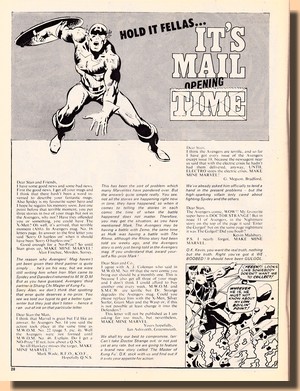 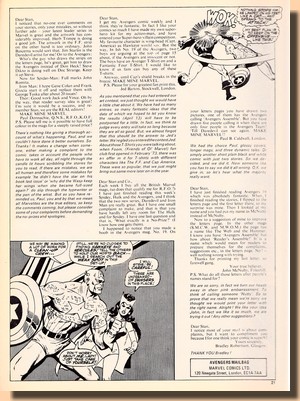 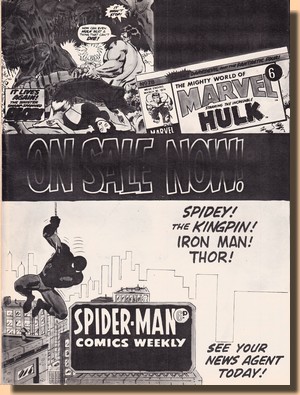 |
| |
| Also of note, on the back cover, is a competition
readers could enter into and for which the first prize
was an inflatable rubber dingy boat. The inclusion of the
Hulk appears rather forced but of course adds visual
enhancement to the slogan MAKE WAY FOR
ADVENTURE! MARVEL STYLE. |
| |
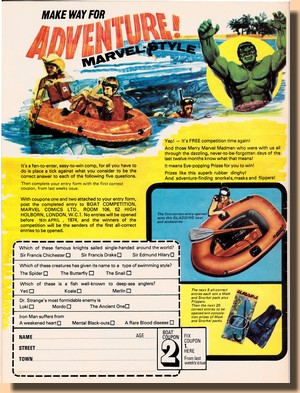 |
|
In order to win one of the prizes
readers had to answer four multiple choice
questions correctly, which were a mix coming from
English history, sealife, and the Marvel
Universe. And the latter had a rather hilarious
touch as one possible answer to "Iron man
suffers from..." was "mental
black-outs". 
BIBLIOHGRAPHY
PEARL Barry (2012) "Lost
in Licensing: Exit Fu Manchu", published
online at Comic Book Collectors Club, June 27th 2012
SACKS Jason (2010) "Top
10 1970s Marvels", published online at
Comics Bulletin, September 10th
2010
|
|
| |
| |
First published
on the web 6 November 2014
updated 19 May 2021
|

(c) 2014-2021

|


























